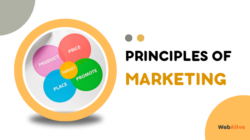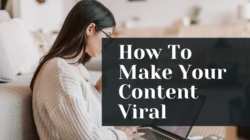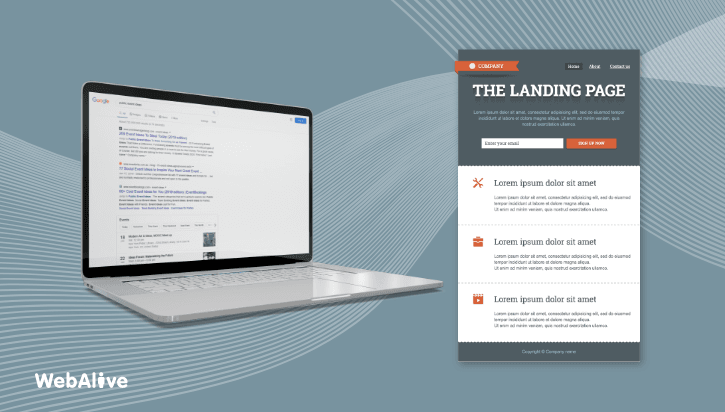
A Complete Guide to Landing Page Optimisation
Since you’ve landed on this article, one thing is for sure – you intend to increase your website’s landing page rankings in SERP, and you want to educate yourself on SEO best practices. Whatever your reason, you have taken a crucial step, as 8 out of every 10 businesses are disappointed in their site’s conversion rate.
Let’s make something very clear. The ultimate purpose of implementing landing page SEO tactics is to convert visitors into leads or paying customers. You are most likely nodding your head in agreement now.
To be able to convert, your landing pages must be among the top results in SERP for their target keywords. The landing page optimisation methods that we are going to discuss will help you achieve just that!
So what exactly is a landing page?
A landing page is a web page that has been specially designed to convert visitors into leads or paid customers. For conversion purposes, a landing page must not have any elements that can even remotely distract a visitor from taking your desired action. Thus the best landing pages have no navigation bar, excessive motion graphics or pop-ups (exit-intent pop-ups are an exception).
With this covered, let’s present the meat of this discussion.
A landing page consists of the following elements:
- Images
- Videos
- Text content
- URL
- Linking
We are going to discuss how to optimize each of these for search engines.
Image SEO tactics
Images are integral to landing pages. Without them, a landing page (or any website for that matter) would be like a skeleton.
Here are some ways you can optimize images for search engines:
Compress the images
When compressed, images take a much shorter time to load. This ensures that your landing page loads faster!
Compressing an image provides a two-fold SEO boost to your landing page. How?
- As your landing page loads faster, it will receive a boost from the search engine to help it rank higher in SERP.
- Because of the higher load-speed of your landing page, its bounce rate would be lower. A lower bounce rate also contributes to a tiny search engine boost!
Insert your target keyword in the image’s filename
When the file name of the images on your landing page has your target keyword or alternate versions of it, Google can easily figure out exactly what the image contains.
If you look at the file names of the images in the screenshot below, you’ll see our point.
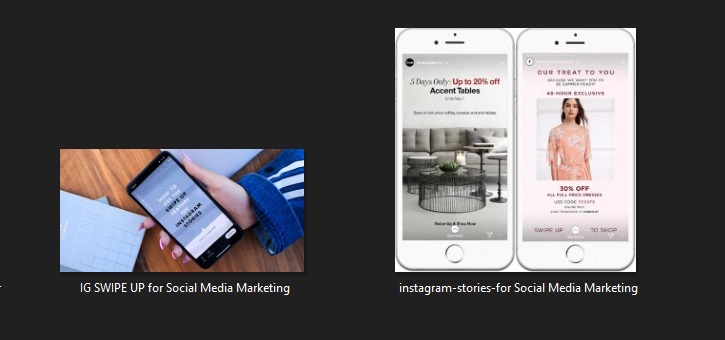
The file names for both images in the screenshot have “social media marketing” in them. As they were used in an article that talks about social media marketing strategies, such file names provide a small SEO boost!
One thing to keep in mind about keyword insertion; do make sure the file names align with image content and don’t feel forced.
Apply “Alt” tags in your images carefully
The “Alt” tag is an HTML attribute.
It is the text that tells search engine crawlers what the content of an image contains since search engines cannot “see” a picture as a human would.
The image below clarifies this much better.
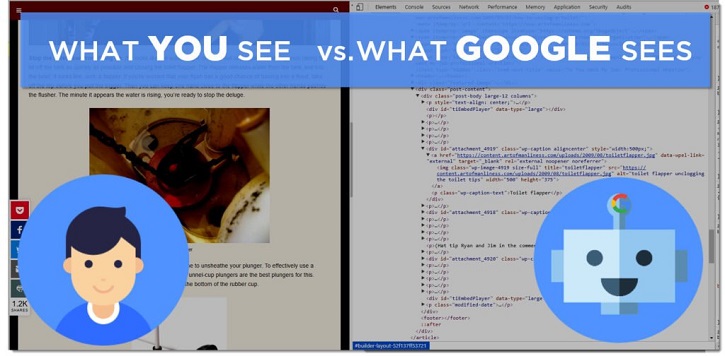
(Source)
Now, you are probably wondering where you can put these “alt” tags. As you can see in the image below, the box pointed to by the red arrow is where you put “alt” tag text in your site’s backend.
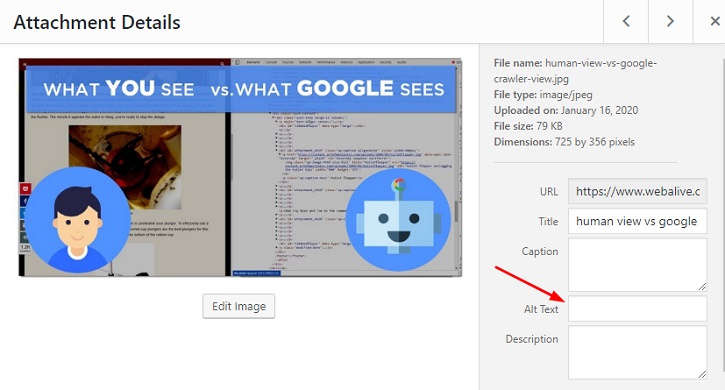
Since these tags tell a search engine what an image contains, it is of paramount importance that you choose them carefully. If your “alt” tags do not describe an image properly, you’ll be depriving your landing page of the SEO boost it could have garnered and as a result, your landing page may suffer in SERP!
Some best practices when it comes to choosing “alt” tags are:
- The text for the tag should be short. Short tags are much easier for Google to index.
- Include your target keyword in the tags.
- Do not forcefully insert your keyword in the tags. Google can sense this, and identifies it as a negative practice.
Make images responsive
You may find this tip very obvious since mobile responsiveness is something everybody takes for granted these days. You might be surprised to hear that about half of all landing pages in the digital space are not responsive!
So how can you make your images responsive for your landing page? In the site HTML code for the image, place the “srcset” attribute to get the job done.
With image optimization tactics for landing pages covered, let us move on to…
Video SEO
Whether you are selling a physical or digital product, you’ll likely need to embed a video on your landing page.
Such a video will explain the product’s potential use, which in turn facilitates lead generation and sales.
Remember the image we showed you above showing how Google processes images?
Well, Google “sees” videos in the same way it “sees” images.
This “impairment” (just kidding! Google is super-smart) provides you with another opportunity to include keywords and tags that can help your landing page rank well.
Here are some of the ways you can optimize the videos on your landing page for Google:
- Use a video title that includes your target keyword. For example, for a promo video for your social listening tool, your title can be “an effective social listening tool.”
- Include properly formatted video sitemaps.
- Provide a transcript for the video on your landing page.
- Choose a thumbnail that intrigues people, making them want to click on it. This helps keep users engaged for a longer time and in turn, reduces bounce rates. The lower the bounce rate, the higher the SEO boost your landing page gets.
- Include social sharing buttons on the video itself. High social engagement tells Google that your video is important to people. This impression improves relevancy and SERP ranking accordingly!
For more tips on optimizing videos for landing page SEO, visit this page.
Related read: 10 Stats to Improve Your Video Marketing Strategy
Text content SEO
You won’t find a landing page in the entire universe that doesn’t contain text content!
Since any and every piece of content placed on your landing page must be optimized, let us tell you how;
Landing page Optimisation tip: Keywords
- Perform keyword research to form a list of long-tail keywords (You can use the Google AdWords Keyword Planner for this purpose).
- Insert your primary keyword within the first one-hundred words on your landing page. Google will love you for this!
- Distribute long-tail keywords throughout your landing page in a relevant manner. Google can sense forceful keyword placement.
- You are welcome to use synonyms of your keywords in your content. Google does not need an exact match to provide relevant results to users.
Landing page Optimisation tip: SERP appearance
- Your landing page title that appears in the SERP should be under 60 characters (8-9 words). This way, it won’t get cut off, ensuring readability.
- Make sure the meta-description for your landing page is under 155 characters (under 27 words). This description appears both in SERPs as well as in social media, so it should be concise and tell people exactly what your landing page content is about.
- Before finalizing the landing page title that appears in SERP and on your page, make sure it is unique. If there are matches, this confuses Google, which may end up prioritizing older pages with the same title as a result.
- Where possible, add modifiers to your landing page title. These could be “case study”, “Industry report”, “detailed review” etc.
- Use star rating and the number of reviews on your landing page along with your text. These tokens of social proof help your page content rank in the SERP snippet section.
Landing page Optimisation tip: Content structure, length and testing
- You must test different versions of your landing page title (the one people see when they land on your page), keyword placement and various other features to find what your visitors prefer. Use an a/b testing tool such as Optimizely or VWO to run these tests.
- Use HTML tags such as H1, H2 and H3 to establish a hierarchy in your landing page content. This way, Google is able to understand your content better and push it up in SERP for the relevant keyword. This practice also helps readers skim your page better.
- Don’t be shy about making your landing pages text heavy! Research has found that longer content is shared more and enjoys higher click-through-rates.
- Use “collapse” div to hide your landing page content. Your visitors will be able to look at the hidden content at the click of a button. Though this doesn’t directly cause an SEO boost, it makes your landing page less overwhelming. People who are genuinely interested in your offer will look at the hidden content. This technique helps improve a user’s session and reduces bounce rate.
If you are interested in more details regarding these tips, do have a look at this article we have selected for you.
URL SEO
Remember, we mentioned above that everything about your landing page has to be optimized? Your page URL needs to be in your optimization scope as much as images and videos!
So, what can you do to optimize the URL of your landing page?
- Your page URL should be a custom one. If it is like the example below, your visitors may doubt your brand’s consistency.

- You can see, the “myshopify” segment in the URL in the image above would confuse people about the site’s ownership. In the worst-case scenario, they could end up questioning its trustworthiness.
- Try limiting your URL to under 65 characters (8-9 words). URLs of this length are indexed better by search engines.
- Use the “slash” character (/) to make search engines aware that you are providing several concepts on your page. Your visitors will find it useful too!
Have a look at the example: https://www.webalive.com.au/seo-friendly-urls/
Linking SEO
Linking SEO is all about practices regarding links to outbound resources, as well as those within your primary website. Like image, video, text and URL SEO practices, the target of this aspect of landing page optimisation is to make your page appear relevant and of higher-authority than other available resources.
Here are some of the best practices when it comes to linking SEO for your landing pages:
- Outbound links should be the too high authority, relevant resources. This practise helps search engines understand the topic of your page better.
- Clicking any link should open the page within your landing page in a smaller, integrated window. This page design tactic helps keep visitors on your page for a longer duration and keep bounce rates low.
- Create backlinks of high authority and traffic pointing to your landing page. Backlinks not only ramp up the number of eyes on your page, but they also help your page rank higher in SERP!
- Create as many interlinks as possible among your landing pages and your primary website resources, covering the same topic. Mass interlinking helps raise the authority of your landing page in the “eyes” of search engines, leading to better ranking.
- Ensure there is no other page in your primary website that is ranking for the same keywords as your landing page. If this happens, then the traffic to your landing page will be split.
Worthy mentions
- Make your landing pages faster; Studies have shown that a 1-second delay in page loading lowers your page conversion by 7%.
- Use 301 redirects to direct your visitors from the less prominent pages in your primary business website/blog to your landing page.
- Make your landing page mobile responsive! Every SEO expert worth their salt has been screaming this out loud, and not for nothing!
- Make the title that appears in the SERP the same as the one that your visitors see when they arrive at your page. This practice encourages them to browse through the rest of the page.
- Social sharing buttons are a must for your landing page. According to HubSpot, people will share anything they find worthy in their social spheres in the digital space. If you ignore this, your landing page is likely to be deprived of the authority and relevance it needs.
Wrapping up
There are just way too many best practices to cover in one article when it comes to landing page optimisation for search engines. Optimization experts are always toying with new tactics because organic SEO is about six times more effective than paid search ads. So what should you do?
Well, do not rest after you have implemented the tips covered in this post. Keep exploring on your own! Who knows, maybe the SEO technique that brings about the next spike in your landing page conversion rate is just around the corner!
You read a lot. We like that
Want to take your online business to the next level? Get the tips and insights that matter.
